Avoiding the Technopoly of Trendy Investments
Posted on — 1 CommentToday, more than ever before, we value technology. The more advanced and sophisticated a piece of technology is, the more we respect it. In his book Technopoly: The Surrender of Culture to Technology, author Neil Postman writes that we live in “a peek-a-boo world, where now this event, now that, pops into view for a moment, then vanishes again. It is an improbable world.” He continues that “it is only now beginning to be understood that cultures may also suffer grievously from information glut, information without meaning.” Though penned a quarter-century ago, these worlds hold particular relevance today as people navigate an ever-expanding labyrinth of investment products like cryptocurrency, ETFs and other digital offerings. His ideas prompt new questions for today’s investor; Does the novelty of an investment’s technology drive real or perceived value?

Many investors pursue outsized gains by seeking early investment trends. As a result, many investment products leverage their unique technological characteristics to position themselves as an emerging trend. When these products market themselves as bold, new alternative investments, people become transfixed by the notion that they’re standing at the doorway of “the next big thing.” In reality, however, the value will ultimately be determined by the underlying methodologies which are often as hollow as the investor’s misplaced value in the technology.
A study of fund returns and total net assets of more than 7,000 mutual funds from 1993 to 2014 illustrates the faultiness of placing value on the technological underpinnings of trendy investments. Researchers Jason Greene and Jeffrey Stark separated the collection of funds by sifting out those that included trendy terms. What did they find? As one journalist explained, “As you might expect, they found that mutual fund families attempt to attract assets by launching ‘trendy’ funds.” The biggest problem, however, is the performance.
The “trendy” funds “under-perform over their first five years compared to non-trendy funds, with the trendiest startup funds underperforming the least trendy startup funds by an average of 1.03 percent per year on a risk-adjusted basis.” Adding to this problem are larger fees (expense ratios). The “trendy” funds had a fees that were, approximately 0.20 percent higher than their non-trendy counterparts on average.
Meanwhile, investments like gold bullion, have enjoyed regular price appreciation over the decades because they exemplify the timelessness of an asset that doesn’t need to leverage an emerging technology as a selling feature. Rater, gold, in all its simplicity, is in stark contrast to tech-heavy products like P2P funds, cryptocurrencies, and smart beta ETFs. Demand for gold is not subject to the whims of technology or fads that inevitably fade. Instead, gold is a global currency that has roots which run deeper than the hot trend.
It’s ironic that the trendiness which propels an investment product is also often the agent of its demise. The reason for this dynamic is simple: a new, flashier trend takes the place of the last one. This phenomenon is in keeping with Postman’s assertion that unquestioned trust in technology serves “to make people believe that technological innovation is synonymous with human progress.” Question the trend.
2 Reasons All this Debt Is So Scary
Posted on — 2 Comments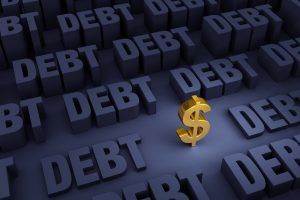
Americans rack up highest debt levels in history
Debt levels are rising. Not only at the government level, but the personal level too.
American consumers recently hit an alarming milestone.
Even though the economy is growing, the labor market is supposedly strong, cash-strapped Americans are taking on more debt than ever.
- Americans now have $1.021 trillion in outstanding revolving credit debt (mostly credit cards), according to the latest report by the Federal Reserve.
That is the largest amount of debt in history.
Meanwhile, the U.S. government sailed past the $20 trillion mark with our federal debt. Right now, policymakers in Washington D.C. are busy proposing legislation that would remove the debt ceiling limit for Congress.
In essence, that would give Congress an ultimate blank check, or a credit card with no credit limit.
Why all this debt is so scary
- This debt is slowing us down
- Higher interest rates will eventually mean the U.S. government must spend more on interest payments and less on services for its citizens
Even if Americans or the government never pay off their debt, they still have to pay the interest on that debt each month.
Are You Prepared For Tomorrow’s Debt Problem?
Even though the Federal Reserve has edged interest rates slightly higher over the past couple of years, they are still very low. Low rates benefit anyone who is paying off debt. But, once interest rates go higher, that means interest on your debt goes higher too.
Why does this matter? At some points interest rates will go up, and perhaps significantly.
Higher rates mean a larger portion of the government’s outlays must go toward debt repayment. That means less for the Social Security and Medicare payments, military, roads, education, and whatever other services the government spends money on.
How low is low?
- Right now, the federal funds rates stands at 1.00-1.25%
- That compares to a “normal” rate of around 4%.
Looking at the U.S. 10-year Treasury yield (the rate most mortgages are based off), before the 2008 global financial crisis, yields were much higher.
- Right now: U.S. Treasury yields 2.26%
- In June 2007, the 10-year yield stood at 5.31%.
- In January 2000, the 10-year yield stood at 6.82%.
- In July 1996, 10-year yields registered a 7.09% reading
- In November 1994 a high was seen at 8.16%.
Debt to GDP ratio
Once government debt levels climb above 90% —that, in and of itself, weighs on economic growth prospects, according to Carmen Reinhart, a professor at Harvard Kennedy School and Kenneth Rogoff, an economist at Harvard University.
The U.S. has already blown past that mark. Debt to GDP ratio stands at 103.1 as of the second quarter, according to the St. Louis Fed.
The U.S. (and other major advanced economies) are already struggling with slow growth for a multitude of reasons. The debt only compounds the problem.
What this means for you
Gold can’t be devalued like paper currency. The Fed can’t “print” more gold any time it’s looking to juice up the economy. Gold is a true, time-honored store of value recognized in every country around the world. There’s many reasons to own gold, and high and rising debt levels may just be another one.
What do you think about the debt problem? We’d like to hear your thoughts.
Markets Drive Themselves, Policymakers Ride Shotgun
Posted onWhen predicting investment growth people often look to the current president for clues. Traditionally, people have believed that the political affiliation of the person occupying the oval office drives movements in the financial markets. Is this assumption well-founded?

Today’s world bears little resemblance to that of our founders. Simply out, there are more moving parts. As a result, the office of the U.S. President, while powerful, wields far less influence than many realize. As one writer for The Atlantic astutely observed, “the president controls one branch of the government, the federal government accounts for merely one-fourth of GDP, and today the U.S. economy is merely a slice (albeit a big slice) of multinational companies’ revenue pie.” The revelation that the president has diminishing control over the financial world has been extended to the broader economy.
“Presidential economic records are highly dependent on the dumb luck of where the nation is in the economic cycle,” explains The New York Times. They continue, “even in areas where the president really does have power to shape the economy – appointing federal reserve governors, steering fiscal and regulatory policy, responding to crises and external shocks – the relationship between presidential action and economic outcome is often uncertain and hard to prove.” This message has particular relevance today because the Federal Reserve is facing a $4.5 trillion balance sheet.
In October, the Federal Reserve will begin the process of reversing the quantitative easing measures taken at the dawn of the global financial crisis. Doing so means gradually reducing the long-term Treasuries and the mortgage-backed securities that comprise much of the $4.5 trillion taken on to ease the strain on the financial system. The process will take years, not months. Meanwhile, other central banks around the world are gradually removing similar support measures. Certain aspects of the market have responded. For example, bond prices have dropped.
However, despite this momentous move, we may learn, once again, that policy has a limited impact on long-term financial market movements, especially gold. As we discussed in a previous post, the correlation between interest rate movements and the price of gold is weak despite long-standing conventional wisdom that they’re linked. Gains occur over the long-term. While policy may influence prices, such events are likely to be short-lived. Interestingly, the illusion of the policy-driven market is due, in part, to investors responding to such policies rather than the directives themselves.
While gold investors may take the Federal Reserve’s news as a signal to alter their holdings the fact remains: markets largely drive themselves while policymakers ride shotgun. In fact, it could be argued that gold is even more resilient than other assets to the policy mandates of the U.S. government. Since 2000 the price per ounce of gold has regularly exceeded the growth of the S&P 500. In truth, impactful changes to an investor’s holdings often, though not always, occur over a much wider period of time. This greater horizon is necessary for a major shift to unfurl. The takeaway: smart investing is long-term investing.
Ethereum and the Death Hoax Problem
Posted onRussian born Vitalik Buterin is a promising youth. From a young age he displayed incredible aptitude for math, economics and even programming. He excelled as an academic. Eventual he became a recipient of the Thiel Fellowship, a grant of $100,000 offered to bright scholars. The selection rate for this privilege is less than 1%. Buterin used his grant to develop a project called “ethereum”, an open-source blockchain currency that sometimes goes by the name “ether.”

His work represents another step in the growing trend of cryptocurrencies, the most famous of which is bitcoin. Many investors are beguiled by the perceived security and modernity of such currencies. As solutions like ethereum have arisen to the mainstream more developers have incited initial coin offerings (ICOs) to fund the underlying systems needed to create new cryptocurrencies. With an ICO, early backers receive a percentage of cryptocurrency in exchange for capital. More programmers are joining the ICO party. In fact, we’re witnessing an average of 20 ICOs per month in 2017. This fervor illustrates a central problem with cryptocurrencies and ICOs; the excitement stems from novelty rather than reliability.
How reliable can a form of currency be if it’s easily upended by something as weak as a death hoax? In late June of this year several sites posted a story about Buterin’s untimely death in a car accident. The article was a complete fabrication. However, what happened next was very real. A flash crash sent values into free fall. Ethereum plummeted from $290 to just 10 cents. All it took was a rumour from a few unreputable bloggers. Eventually, Buterin squelched the news by posting an up to date picture of himself online.
With incidents like this in mind it’s easy to see why recently The People’s Bank of China announced that it will freeze all fundraising through ICOs. Part of this decision comes from a distrust of anonymous transaction systems that can be used to finance terror or exchange illegal goods on the black market. This decision also caused bitcoin and ethereum to tumble. ICOs appear to be less about bringing a revolution to the world of currency and more about bringing money to the pockets of founders. TechCrunch reported that “Chinese companies had raised $383 million from 105,000 investors during the first half of the year.” The real money rests with the people creating the offering, not the broader public.
Meanwhile, gold continues to offer a solution even the brightest Thiel Fellowship recipient cannot conjure. The metal is not subject to the whims of online pranksters, electrical impulses or opportunistic ICOs. Ethereum emerged from the pages of Buterin’s white paper and because it’s a construct on one person’s theorizing, it is subject to the same flaws that plague all ideas still in development. Gold, however, offers a tangibility that transcends code.
Even the most dedicated cryptocurrency investors would have to concede that volatility alone remains a problem. Even if one is “sold” on the future of cryptocurrency as an ongoing form of payment, the fact remains: it’s wildly unpredictable. As Bloomberg reported, “an asset that rises and falls 20 percent in a day doesn’t make for a good medium of exchange with which to buy coffee.”
Stocks Rally to New Highs
Posted onStocks in the US started last week off with a bang, as the three benchmark stock indices all rallied on Monday amid lessening tensions with North Korea.
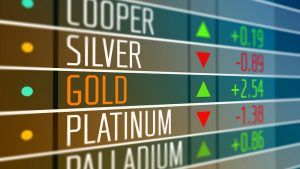
As mentioned in last week’s article, there was a significant amount of market apprehension about the events that could take place over the weekend, i.e. a missile attack. However, Emini S&P 500 futures gapped up Sunday evening by approximately 5 points as the possibility of a North Korean missile strike dwindled over the weekend. The strong Emini S&P 500 futures rally continued throughout the night and into Monday’s trading session.
The S&P 500, and the Dow Jones Industrial Average both rallied into the close on Monday to settle at fresh all-time highs, with both indices closing more than 1% in the green.
Although Monday’s rally seemed to lose a little bit of momentum mid-week, bids started flowing into the market again on Friday as prices began to drift towards new all-time highs.
For the week, the Dow Jones advanced the most with over a 2% gain. The Nasdaq 100 and S&P 500 both closed around 1.4% higher.
North Korea ended up shocking the world by actually firing a missile over Japan early Friday morning. There was an initial knee-jerk reaction to the launch that sent S&P futures about ten points lower, but investors clearly used the sell-off as an opportunity to add to their long positions after they digested the news.
The Dow Jones went on to make its 39th record high of 2017 on Friday, along with the S&P 500. Although the Nasdaq 100 didn’t make a new record, it still closed largely positive.
“In general, and the markets have kind of figured this out, geopolitical events are fairly short lived. You have to be careful of them and they will create stress moments in the market, perhaps corrections, but they don’t tend to last,” said Matthew Peron, head of global equities for Northern Trust Asset Management which oversees about $1 trillion in assets.
This certainly seemed to be the case with North Korea. Strong gains in the stock market, especially after the missiles were fired, confused a lot of investors due to the amount of fear and uncertainty that was priced into the markets in weeks prior.
The last thing market participants expected was for stocks to rally after North Korea finally tested their missiles after weeks of threats.
Most of the market’s gains were powered by a solid rally in technology stocks. Nvidia Corporation (NVDA), gained 5.9% on Friday alone amid analysts price-target upgrades, which contributed to a significant portion of the Nasdaq’s spike. Similarly, Advanced Micro Devices (AMD) was up 2.2% on Friday which boosted both the S&P 500 and the Nasdaq.
Although there was a brief surge in safe haven assets immediately after the North Korean missiles landed near Japan, the flight to safety didn’t last.
Gold for December delivery was trading around $1,325 per ounce on Friday after declining almost 2% for the week. However, given that gold just made a new YTD high only one week ago, slight declines are not too alarming.
Since 1975, Blanchard has successfully helped over 450,000 clients invest wisely in precious metals and rare coins. Our team of experts are always here to help you make the right investment decisions and capitalize on opportunities in the precious metals market.
Call us today at 800-880-4653
Is The U.S. Dollar Losing Its Role As the Global Reserve Currency?
Posted onThe U.S. dollar is the world’s reserve currency. For now.
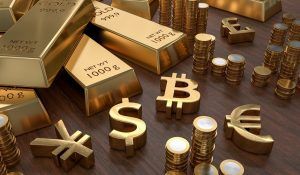
Being the global reserve currency means that when commodities from grain to oil are bought and sold between countries the medium of exchange is the U.S dollar. That benefits the U.S. because there is on-going demand for U.S. dollars. China must use U.S. dollars to pay Brazil for soybeans, or pay Russia for oil.
That’s changing. Over the past several years there has been a significant movement in the world trading community to squeeze the U.S. dollar out of the picture.
Russia and China have cut deals and now trade crude oil with yuan, not U.S. dollars.
The trend to squeeze the U.S. dollar out of the picture is picking up speed.
New Crude Oil Contract Cuts Dollar Out
China is now developing a brand new crude oil futures contract that would be priced in yuan and convertible into gold. It is expected to become a third global benchmark for crude oil trade.
This is significant as it allows countries to buy and sell crude oil, bypassing U.S. dollars. For those countries who aren’t comfortable yet with accepting yuan, the futures contract is convertible into physical gold. That means oil producers could get paid for selling their oil in physical gold. That’s a smart move on the part of the Chinese. Everyone acknowledges and accepts the value of gold.
A Little Background
China is the world’s second largest economy and in recent years has been demanding a seat at the table at global financial and monetary institutions. In late 2016, the International Monetary Fund added the renminbi (yuan), to its elite basket of reserve currencies in the Special Drawing Rights (SDR).
That was a momentous event for the Chinese currency and marked an international stamp of approval to use the yuan in the global economic system. The Chinese currency jumped onto the global currencies “A” list basket along with the euro, yen, pound and dollar.
The new Chinese futures contract, however, will be convertible into physical gold. That represents some hesitation on the part of the global financial community regarding the Chinese yuan.
“In order for the renminbi to be considered a safe place for investors to put their money in times of turmoil, foreign investors and domestic investors in China must have trust in China,” says Cornell University economist Eswar Prasad. “And that is missing,” he adds.
In order to develop global trust in the yuan, China needs political and legal institutions like those in Europe, the United States and Japan. China does not have a democratic form of government with multiple checks and balances. It needs an independent and trusted central bank like the Federal Reserve. And China also would require a legal framework where the rule of law takes precedence over the Chinese Communist Party, and not vice versa, Prasad says.
The Rise and Fall of Reserve Currencies
For decades the U.S. dollar held a special spot in the world financial community. Being the world’s reserve currency accords a country a special economic status. History shows that reserves currencies come and go. It would be foolhardy to assume the U.S. dollar will be the reserve currency forever.
From the Arab dinar in the Middle Ages to the Florentine florin in the Renaissance to the Dutch guilder to the British pound, reserve currencies change with time.
We are in the midst of a transition now. There is no clear currency that could replace the dollar, and that is in part why the shift is slow. But, there is movement. Some talk about how the SDR could become new global reserve currency. Read one view on that here.
What Does This Mean For You?
The decline of the U.S. dollar will come with a heavy price for Americans. It will mean less demand for dollars by world trading partners. That means an even greater glut of the U.S. paper currency, which is already declining in value. It also means higher U.S. interest rates. The U.S. runs a highly indebted economy. For now, foreigners are happy to finance our debt as they need U.S. dollars to buy and sell critical global commodities.
What happens when that changes?
For the individual investor, these developments are largely out of your control. It is likely only a matter of time before the U.S. dollar has less and less prominence on the world stage. With that come higher interest rates and less purchasing power of the dollar.
As the U.S. paper money decreases in value, the true value of hard assets like physical gold become even clearer.
Gold is a good insurance policy and a portfolio diversifier. New research from the CPM Group shows that between 1968 and 2016 your portfolio would have performed best if you had 27-30% of your portfolio in physical gold.
You can’t control what will happen to the U.S. dollar’s status as a reserve currency. But, you can control what’s in your portfolio now.
If you are concerned about the impact of the changing global conditions on your investments, please share this article with your family and friends. They need to know too.
Understanding Gold’s Place in Modern Portfolio Theory
Posted onThere are countless ways to invest. Some prefer to simply “buy the market” and choose an equity index fund. Others have a more risk-averse approach choosing instead to stick with more predictable fixed-income products. However, all these different styles should include a consideration of modern portfolio theory (MPT). The reason: MPT is an important concept that applies to virtually all investing styles, even those that include exposure to gold.

MPT represents the practice of seeking the highest possible return for a given level of risk. What makes the theory so intriguing is the way in views individual investments. MPT asserts that investors should not consider each component of their portfolio in isolation. Rather, each asset should be selected with consideration for how it impacts all the other holdings in the portfolio. MPT advocates for context.
However, engaging this concept can be difficult for gold investors because gold has so many singular characteristics that seem to have little relation to those of stocks, bonds and real estate. In fact, this uniqueness is the basis of its appeal for most investors. The question is: what allocation of gold is optimal in a portfolio? The answer, according to MPT, depends on what’s included in the rest of the portfolio. For the sake of simplicity, we can assume the other part of the portfolio is an S&P 500 index fund, a popular choice for today’s investors.
Revealing research from analysts offers some surprising answers to this question. In a segmented approach, the researchers looked at what gold/S&P 500 ratio would maximize the investor’s return over three periods of time, 2004-2014, since 1971 and since 1934.
To determine the optimal proportions, they had to consider what’s called the “efficiency frontier.” This is a curved line that sits on an “X,Y” axis. The points along the curve represent the highest possible return on an investment possible before the risk exposure becomes too great for that level of return.
The researchers found that from February 28, 2004 to February 28, 2014 a portfolio represented by only the S&P 500 would have earned an annualized return of 7.14%. Meanwhile, a portfolio of 100% gold would have delivered 12.84%. The diversified investor interested in holding both could have an optimized their balance with 68% gold and 32% S&P 500 offering an annualized return of 11.28%. Moreover, the annualized risk was actually lower than either holding all gold or all S&P 500. That’s the magic of MPT; you get an optimized return without unnecessary exposure to risk.
The researchers also determined that since 1971 the optimal gold allocation and S&P 500 allocation was 29% and 71% respectively. However, as the timeline expanded and they looked at the data since 1934 they found that investors choosing to hold both would have maximized their return with a portfolio of 41% gold and 59% S&P 500.
Eventually, the founder of MPT went on to earn the Nobel Prize in Economics. His work shows us how our conventional understanding of portfolio allocation can be flawed. While most people advocate for tempering their gold exposure, MPT and the hard figures behind the research show that investors can earn more with a larger investment in the metal.
Choosing Between Gold and Bitcoin in Times of Fear
Posted onRecent headlines have been a constant reminder of destabilized relations with North Korea. As CNN reports, “The country has fired 21 missiles during 14 tests since February.” This frequency signals a powerful drive by North Korea to gain attention as a nuclear capability on the world stage. “Less than six years into his reign, Kim Jong Un has tested more missiles than his father and grandfather combined,” continued the reporting.
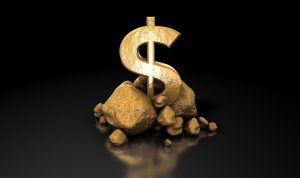
This development has alarmed Americans fearful that North Korea leader Kim Jong Un will soon reach a level of engineering sophistication necessary to incite a war. Meanwhile, the United Nations Security Council adopted a new resolution from the U.S. to impose new sanctions on the country. The move aims to limit oil imports, ban textile exports and stop joint efforts with other nations. Investors are taking notice.
In recent weeks, we’ve seen financial markets move in step with rising and falling fears stoked by Kim Jong Un. At the same time, gold has seen a rise as investors turn the the “safe haven” characteristics of the currency. Simultaneously, cryptocurrencies have risen for similar reasons. These tandem movements have led some to compare the two investments. “Approximately $155 billion in cryptocurrencies are in circulation around the world right now. Bitcoin by itself is at $78 billion, which is close to the $90 billion invested in all gold ETFs,” remarked Forbes. Some investors are asking where their assets are best held, in bitcoin or gold?
Proponents of bitcoin often advocate that the “supply is mathematically metered” and therefore much more likely to grow in value over time whereas “the global gold supply has inflated steadily over the last hundred years,” according to authors at ARK Invest and Coinbase Inc. While these statements are true, they ignore an important counter argument. Bitcoin is still exposed to “counterparty risk.”
We have previously discussed counterparty risk at Blanchard. In short, counterparty risk is the risk inherent in an investment, like equities, that involves another party. If this group doesn’t hold up their end of the deal you, as the investor, can be left holding the bag. A publicly traded company (like Enron) might reveal themselves as fraudsters losing millions of shareholder investments. The technological marvel and novelty of bitcoin often leads investors to forget that with such an investment counterparty risk is very real.
However, if the transactions behind bitcoin are purely democratic, peer-to-peer, and on a shared, open ledger, how does counterparty risk enter the picture? This is where we return to North Korea’s saber rattling.
Bitcoin needs the internet to live, gold doesn’t. In a full military strike, infrastructures like the country’s internet are likely to be a primary target. Gold survives even without the supporting structure of technology.
Bitcoin, like the fiat currencies it eschews, is man-made. Technology is such a ubiquitous presence in our lives we often forget that it’s even present. Bitcoin investors would do well to temper their support for such a new asset that has not yet been tested against the leveling effect of warring nations especially in the nuclear age.
Why the China Caixin Manufacturing Index Matters to Metal Investors
Posted onIn the U.S. investors are often fixated on the S&P 500, the Nasdaq, or the Dow Jones. Few know of the Caixin Purchasing Managers Index (PMI). Even fewer pay attention to it, but they should. Why? It’s an important industrial metal indicator for one of the world’s economic powerhouses.

China’s Caixin Manufacturing Index is expressed as a number. The figure represents the outcome of a survey of small and mid-sized businesses in China and their appetite for industrial metals like copper and nickel. Why does this matter? China is the world’s largest metal consumer and the second largest economy on the planet and the number is rising.
In August the figure reached a six-month high of 51.6. This value beat all expectations signalling a more robust than expected Chinese economy. The head of strategy for Asia Pacific and emerging markets at Merrill Lynch remarked, “The world economy is in a pervasive growth mode where 85 percent of the countries that we track in the world have PMIs that are above 50. That’s very, very high and I expect that to continue.” China’s healthy demand comes not only from industrial expansion and favorable economic tailwinds but also renewed focus on environmental improvement.
Recently, China committed to the average concentration of airborne particles by over 15 percent a year in 28 northern cities. As Reuters explains, “China’s efforts to control pollution have often roiled the prices of steel, iron ore and coal with output routinely curtailed as a result of emergency smog regulations and inspection campaigns.”
While industrial metals are used for infrastructure projects the measurement has implications for gold. Part of this reason stems from the fact that a strong Caixin PMI figure represents a strong Chinese economy. With a strong Chinese economy comes reinvigorated gold purchases. This is evidenced by an 11% year-over-year increase in coin and bar demand led, in part, by China. These numbers represent not only a commitment to building bullion reserves but enabling growth within the tech sector. The World Gold Council reported that in Q2 of 2017 “Technology demand registered its third consecutive quarter of growth: up 2% to 81.3t. Growth in wireless charging and development of features that use LEDs boosted demand. New smartphone handsets supported chip production.”
Components like memory chips are in constant demand. Meanwhile, LEDs, PCBs, and bonding wire are all common electronic parts requiring some amount of gold for production. Simultaneously, “Research into new applications for gold continued to grow” reported The World Gold Council.
Industrial metals build the factories. The factories build components that require gold. This connection underscores the value of a deeper interpretation of the
Caixin Purchasing PMI. The latest measurement comes amid the fastest expansion seen in 37 months.
As the world continues to evolve into a global economy we’re witnessing the pervasive effects of China’s industrial growth. While supply and demand have enormous influence our “flat earth” economy is so interconnected that even China’s environmental policy can impact prices.
Gold Climbs 16%: Is It Overvalued Now?
Posted onFact: It is rarer to find a one ounce nugget of gold than a five carat diamond.
Gold is rare, precious and recognized as a store of value around the globe. In recent weeks, individual investors and global money managers shifted assets into gold, silver and other precious metals as political and economic risks climb. Gold prices are now 16% higher than the start of 2017.

Last week, spot gold surged past its November 2016 (pre-Trump election) high at $1,307 per ounce. After gold bulls stalled out three time at the $1,300 per ounce level earlier this year, the late August and September rally in gold tore through that ceiling. See Figure 1 below.
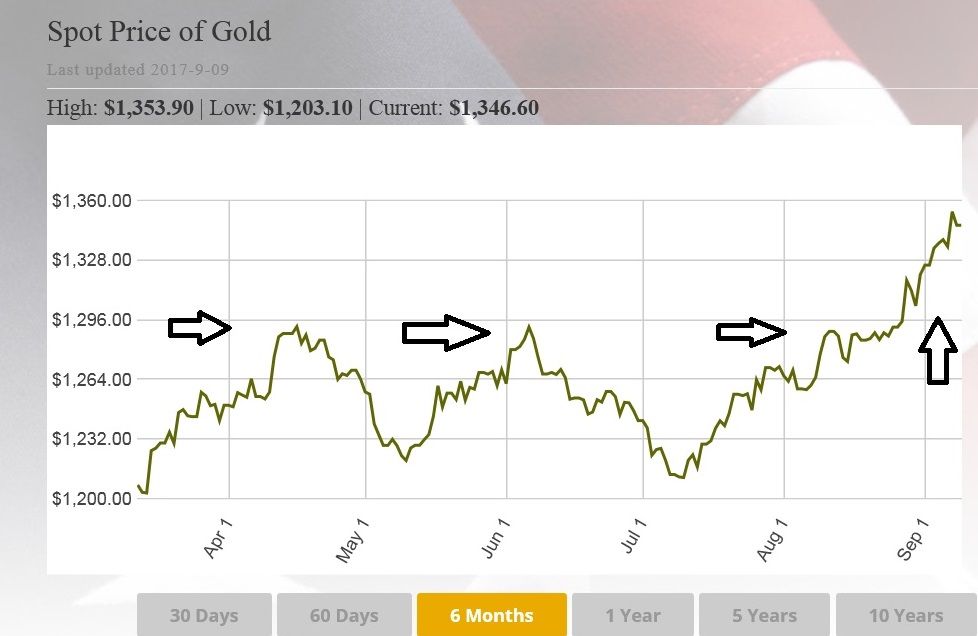
Is Gold Overvalued?
The recent runaway gains in gold might have you wondering: is gold overvalued?
The good folks at CFRA Research, a highly regarded New-York based independent research firm dug into historical numbers, relative to stock prices, to try to answer that question. Get ready for a little bit of math.
Gold versus the S&P 500
“Daily prices going back to 1968 show that the median relative price of stocks versus gold (the level of the S&P 500 divided by the price of an ounce of gold) was 1.20, meaning that the stock index has been worth 20% more than the price of gold,” CRFA says.
“While the relative valuation has experienced ups and downs over time, the latest tilt in favor of stocks over gold that took hold in 2012 can be attributed to the easy money policies across the globe, making risk assets more attractive and have been supported by the search for growth that many investors have embarked upon. Further, this shouldn’t be that surprising given the low inflationary environment we have enjoyed for the better part of the last decade as gold is often used as an inflation hedge,” CFRA says.
The Bottom Line: Gold Is Cheap Relative to Stocks
As of late August, the relative valuation stood at 1.91, implying that stocks are 71 basis points more expensive than gold, according to CFRA research.
“Or said in reverse, gold is 71 basis points cheaper than stocks, implying more value in gold than in stocks. Therefore CFRA doesn’t think gold is overvalued at these levels. In fact, as the relative valuation nears the level of one standard deviation greater than the median (at 2.39), CFRA anticipates gold returning to favor over stocks,”
How High Could Gold Rally?
The sky is the limit. History can be a guide to help determine the answer to that question.
In August, 2011, the spot price of gold hit $1,899 per ounce. See for yourself. Got a minute? Here’s how you can see that now:
- Navigate to Blanchard’s spot gold price page here.
- Click on 10 Years to see spot prices over the past decade.
Voila. You can see there’s a lot of upside ahead. An ounce nugget of gold is rarer than a 5 carat diamond. Geology doesn’t change. Gold has held its value for thousands of years and is on the rise now. If you’ve been meaning to increase your allocation to tangible assets, don’t delay, next month prices will likely be even higher.







